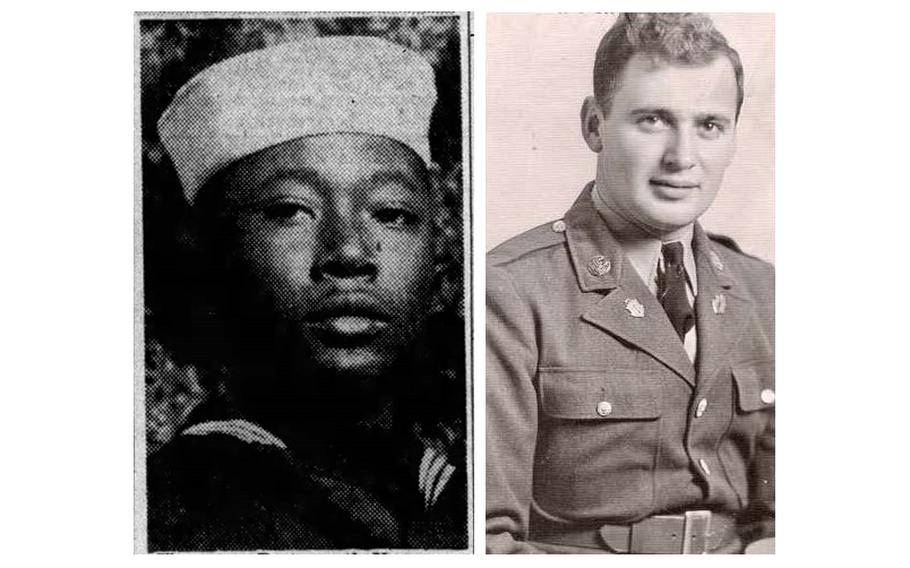
U.S. Navy Mess Attendant 3rd Class David Walker, left, and U.S. Army Cpl. Frank V. Benak (Defense POW/MIA Accounting Agency)
The remains of two World War II veterans who went missing in action were recently accounted for by the Defense POW/MIA Accounting Agency, and will have U.S. burials later this year.
U.S. Navy Mess Attendant 3rd Class David Walker, 19, of Norfolk, Va., was accounted for Nov. 27, 2023, and U.S. Army Cpl. Frank V. Benak, 24, of Scottsville, Mich., was accounted for Feb. 2, the DPAA announced Thursday.
Walker was assigned to the battleship USS California, which was attacked by Japanese aircraft while moored at Ford Island, Pearl Harbor, Hawaii, on Dec. 7, 1941. The California sustained multiple torpedo and bomb hits, causing it to catch fire and slowly flood and resulting in the deaths of 103 crew members, including Walker.
Navy personnel recovered the remains of the crew from December 1941 to April 1942, and these remains were subsequently interred in the Halawa and Nu’uanu cemeteries. Forty-two crewmen were initially identified after the attack, and in September 1947, members of the American Graves Registration Service (AGRS) disinterred the remains and transferred them to the Central Identification Laboratory at Schofield Barracks but were only able to identify 39 men at the time. The unidentified remains were buried at the National Memorial Cemetery of the Pacific, known as the Punchbowl, in Honolulu.
In 2018, DPAA personnel exhumed the 25 California unknowns from the Punchbowl for analysis. Walker’s remains were identified by scientists from DPAA using anthropological and dental analysis. Additionally, scientists from the Armed Forces Medical Examiner System used mitochondrial DNA (mtDNA) analysis.
Walker’s name is recorded on the Walls of the Missing at the Punchbowl, along with the others who are missing from WWII. A rosette will be placed next to his name to indicate he has been accounted for.
Walker will be buried Sept. 5 in Arlington National Cemetery.
Benak was assigned to Cannon Company, 128th Infantry Regiment, 32nd Infantry Division, and deployed in present-day Papua New Guinea in December 1942. In an attempt to neutralize Japanese forces near the town of Buna, Benak’s unit attacked enemy defensive positions in the north. Benak was reported missing in action on Dec. 5 while on combat patrol near Buna Creek.
The AGRS concluded searches of battle areas and crash sites in Papua New Guinea in 1948. A set of remains that were initially found in 1944 near where Benak was killed could not be positively identified and were eventually interred as unknowns at Fort McKinley Cemetery, now Manila American Cemetery and Memorial in the Philippines.
In May 2012, Australian Defence Force personnel looking for unresolved casualties near Buna, found an identification tag belonging to Benak in the possession of a village leader at Buna. A set of remains from Manila American Cemetery, X-168 Finschhafen #2 was disinterred in January 2017 following a yearslong investigation.
To identify Benak’ remains, scientists from DPAA used dental and anthropological analysis, as well as circumstantial evidence. Additionally, scientists from the Armed Forces Medical Examiner System used mitochondrial DNA (mtDNA) and autosomal DNA (auSTR) analysis.
Benak’s name is recorded on the Walls of the Missing at the Manila American Cemetery and Memorial, along with others still missing from WWII. A rosette will be placed next to his name to indicate he has been accounted for.
Benak will be buried April 13 in Miami.
As of May 2023, more than 81,000 Americans remain missing from WWII, the Korean War, the Vietnam War, the Cold War and the Gulf Wars/other conflicts. Out of the total, approximately 75% of the losses are located in the Indo-Pacific region, and over 41,000 of the missing are presumed lost at sea (such as ship losses and known aircraft water losses).